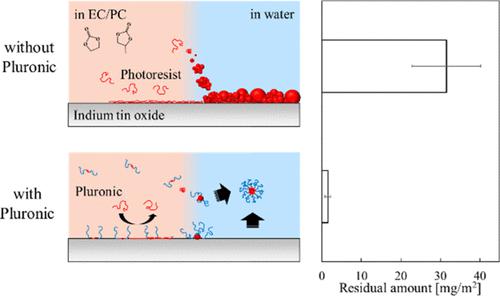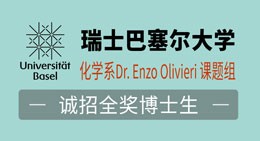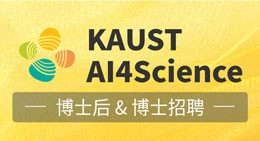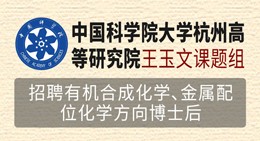Our official English website, www.x-mol.net, welcomes your
feedback! (Note: you will need to create a separate account there.)
Anti-adsorption Mechanism of Photoresist by Pluronic Surfactants: An Insight into Their Adsorbed Structure
Langmuir ( IF 3.7 ) Pub Date : 2023-05-20 , DOI: 10.1021/acs.langmuir.3c00714
Masaki Hanzawa 1 , Taku Ogura 1, 2 , Koji Tsuchiya 2 , Masaaki Akamatsu 3 , Kenichi Sakai 2, 4 , Hideki Sakai 2, 4
Langmuir ( IF 3.7 ) Pub Date : 2023-05-20 , DOI: 10.1021/acs.langmuir.3c00714
Masaki Hanzawa 1 , Taku Ogura 1, 2 , Koji Tsuchiya 2 , Masaaki Akamatsu 3 , Kenichi Sakai 2, 4 , Hideki Sakai 2, 4
Affiliation

|
Photoresist stripping is the final step in the photolithography process that forms fine patterns for electronic devices. Recently, a mixture of ethylene carbonate (EC) and propylene carbonate (PC) has attracted attention as a new stripper based on its eco-friendliness and anti-corrosiveness. However, the EC/PC mixture causes re-adsorption of the photoresist during a process of subsequent water rinsing. In this study, we characterized the adsorption/desorption of the photoresist and a triblock Pluronic surfactant [poly(ethylene oxide)–poly(propylene oxide)–poly(ethylene oxide)] as a blocking agent on an indium tin oxide (ITO) substrate. In addition, we evaluated the dispersion of photoresist particles. The photoresist polymer formed a thin and rigid adsorption layer on an ITO substrate in the EC/PC mixture. When water was injected into the EC/PC mixture and the photoresist solutions, the photoresist polymer aggregated and was then deposited on the substrate. In contrast, the addition of Pluronic surfactant F-68 (PEO79PPO30PEO79) into the EC/PC mixture remarkably decreased the residual amount of the photoresist on the ITO after water injection. This variation was attributed to the PEO blocks of F-68 extended to the solution phase, whereas the PPO blocks of F-68 functioned as anchors for adsorption onto the photoresist. Therefore, the F-68-adsorbed layer prevented interaction between the photoresist particles or the photoresist and the ITO surface, which provides potential for future applications as new stripping agents with high removal performance.
中文翻译:

Pluronic 表面活性剂对光致抗蚀剂的抗吸附机制:对其吸附结构的洞察
光刻胶剥离是形成电子设备精细图案的光刻工艺的最后一步。最近,碳酸亚乙酯 (EC) 和碳酸亚丙酯 (PC) 的混合物作为一种新型剥离剂因其环保和耐腐蚀性而受到关注。然而,EC/PC混合物在随后的水洗过程中引起光致抗蚀剂的再吸附。在这项研究中,我们表征了光致抗蚀剂和三嵌段 Pluronic 表面活性剂 [聚(环氧乙烷)– 聚(环氧丙烷)– 聚(环氧乙烷)] 作为阻断剂在氧化铟锡 (ITO) 基板上的吸附/解吸. 此外,我们评估了光刻胶颗粒的分散。光致抗蚀剂聚合物在 EC/PC 混合物中的 ITO 基板上形成薄而硬的吸附层。当将水注入 EC/PC 混合物和光刻胶溶液时,光刻胶聚合物聚集,然后沉积在基板上。相反,添加 Pluronic 表面活性剂 F-68 (PEO79 PPO 30 PEO 79 )加入EC/PC混合物中显着降低了注水后ITO上光刻胶的残留量。这种变化归因于 F-68 的 PEO 块延伸到溶液相,而 F-68 的 PPO 块用作吸附到光刻胶上的锚。因此,F-68 吸附层阻止了光刻胶颗粒或光刻胶与 ITO 表面之间的相互作用,这为未来作为具有高去除性能的新型剥离剂的应用提供了潜力。
更新日期:2023-05-20
中文翻译:

Pluronic 表面活性剂对光致抗蚀剂的抗吸附机制:对其吸附结构的洞察
光刻胶剥离是形成电子设备精细图案的光刻工艺的最后一步。最近,碳酸亚乙酯 (EC) 和碳酸亚丙酯 (PC) 的混合物作为一种新型剥离剂因其环保和耐腐蚀性而受到关注。然而,EC/PC混合物在随后的水洗过程中引起光致抗蚀剂的再吸附。在这项研究中,我们表征了光致抗蚀剂和三嵌段 Pluronic 表面活性剂 [聚(环氧乙烷)– 聚(环氧丙烷)– 聚(环氧乙烷)] 作为阻断剂在氧化铟锡 (ITO) 基板上的吸附/解吸. 此外,我们评估了光刻胶颗粒的分散。光致抗蚀剂聚合物在 EC/PC 混合物中的 ITO 基板上形成薄而硬的吸附层。当将水注入 EC/PC 混合物和光刻胶溶液时,光刻胶聚合物聚集,然后沉积在基板上。相反,添加 Pluronic 表面活性剂 F-68 (PEO79 PPO 30 PEO 79 )加入EC/PC混合物中显着降低了注水后ITO上光刻胶的残留量。这种变化归因于 F-68 的 PEO 块延伸到溶液相,而 F-68 的 PPO 块用作吸附到光刻胶上的锚。因此,F-68 吸附层阻止了光刻胶颗粒或光刻胶与 ITO 表面之间的相互作用,这为未来作为具有高去除性能的新型剥离剂的应用提供了潜力。

































 京公网安备 11010802027423号
京公网安备 11010802027423号